The M.Zuiko 7-14mm f/2.8 is the third professional zoom designed by Olympus. It is also the second super-wide angle zoom lens for the Micro Four Thirds system but has a constant aperture of f/2.8 instead of f/4, as found on the Panasonic 7-14mm. It goes without saying that many users were interested in the idea of a faster wide angle zoom lens that could provide more versatility than the Panasonic version.
I had the chance to see and try out a prototype of the new lens during the E-M5 Mark II launch in Prague a few months ago, but I wasn’t allowed to bring the pictures home. Despite playing with it for only a few minutes in the tiny corridors and spaces of the abandoned factory, what I saw looked promising.
The 7-14mm f/2.8 gives you an equivalent zoom range of 14-28mm on the full-frame format, which is the classic ultra-wide angle zoom lens you can find for many systems. It is a lens whose optical quality managed to surprise me more than once. It is not perfect but it is at the highest standard that Micro Four Thirds lenses can deliver in terms of image quality. It is also a very versatile lens despite its wide nature.
After shooting with this lens for over three weeks, I can safely say right away that the 7-14mm f/2.8 is another great addition to the m4/3 system.
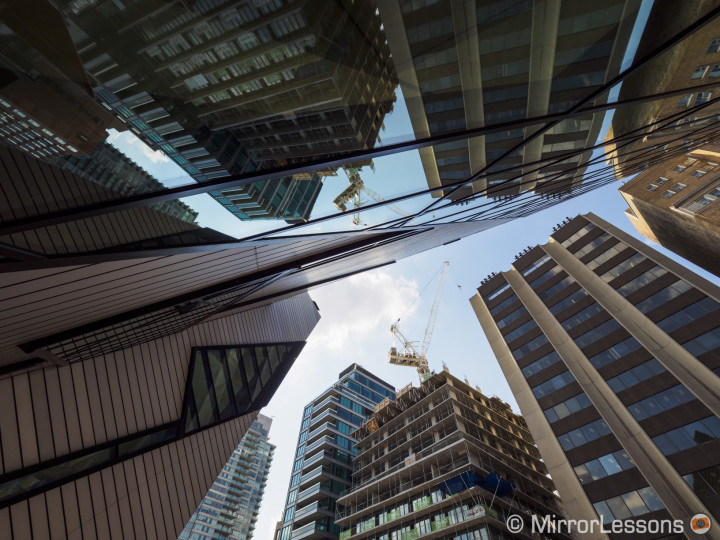
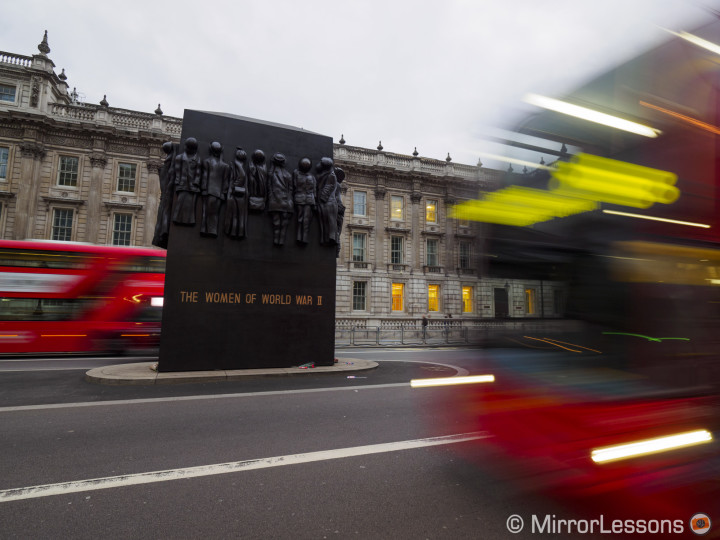
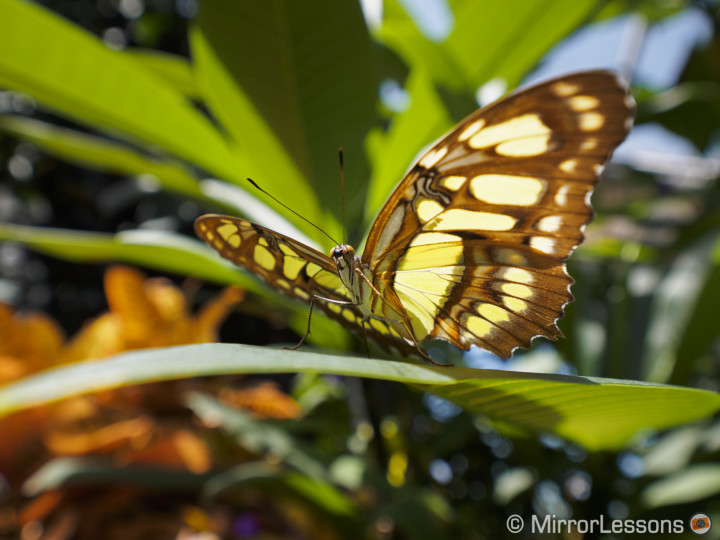
M.Zuiko Digital ED 7‑14mm 1:2.8 PRO Specs
- Focal length: 7-14mm
- Focal length (equiv. 35mm): 14-28mm
- Maximum aperture: 2.8
- Minimum aperture: 22
- Number of aperture blades: circular aperture diaphragm
- Angle of view: 114 – 75°
- Closest focusing distance: 7.5cm
- Lens configuration:14 elements / 11 groups
- Special elements: 2 Aspherical ED, 1 DSA, 1 Aspherical, 3 Super ED, 1 ED and 2 HR elements
- Lens surface coating: Yes (Zero Coating)
- Maximum image magnification: 0.12x (max.)
- Optical Image Stabilizer: None
- Dimensions: φ78.9 Ø, 105.8 mm
- Filter diamater: None
- Weight: 534g
Table of Contents
Design and ease of use
The 7-14mm has the same build quality as the other Pro series lenses. You get an all-metal build on the surface except for the non-removable hood which is made of plastic. The lens is splash, dust and freeze proof down to -10°C. The provided lens cap attaches on the external side of the built-in hood. It is similar in size to the M.Zuiko 12-40mm Pro but is slightly larger in diameter.
The lens is also heavy (534g). Actually it is the heaviest Micro Four Thirds zoom lens I’ve tested excluding the M.Zuiko 40-150mm f/2.8.
On the OM-D E-M1 you can achieve a good balance thanks to the integrated front grip of the camera. On the E-M5/E-M10 series it can be slightly more uncomfortable to use. I shot mainly with the E-M5 mark II during these past three weeks and I got used to it in the end but an optional landscape grip could be a good investment if it becomes your go-to lens.
The zoom ring feels nice and is precise to use. The focus ring is of course a “focus by wire” type. It can be clutched to reveal the distance scale and instantly switch from auto to manual focus. There is also an Fn-L button on the side to which you can assign a custom function via the camera’s menu. I usually use it to lock the focus point as I find its position really comfortable.
The zoom mechanism is internal so the lens doesn’t physically extend. You can notice however the front element moving forward when set to the shorter focal lengths. While it stays underneath the plastic hood, at 7mm the front element is very much exposed, so when not shooting I advise you to set it back to 14mm to protect it.
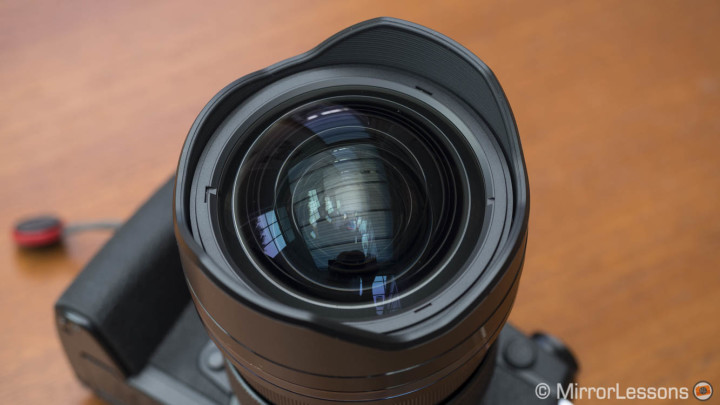
There isn’t the option to attach a circular filter thread. Olympus won’t produce an optional filter holder so we will have to wait for a third party manufacturer to do it. LEE recently announced a filter holder designed especially for Super Wide angle lenses. For now only DSLR lenses are compatible but they should increase the list soon. Let’s hope that the 7-14mm f/2.8 will also be included.
Through the lens: sharpness and distortion
The lens is really sharp and is up to the standard that Olympus has already shown us with the M.Zuiko 12-40mm f/2.8. At the centre, I didn’t notice any decrease in sharpness throughout the entire zoom range and from f/2.8 up to f/5.6. If we start to pixel peep a little more, we can notice that at f/8 there is a slight loss in sharpness especially at the longer focal lengths. From f/16 up to f/22 there is some diffraction too, which is nothing out of the ordinary for a Micro Four Thirds lens.
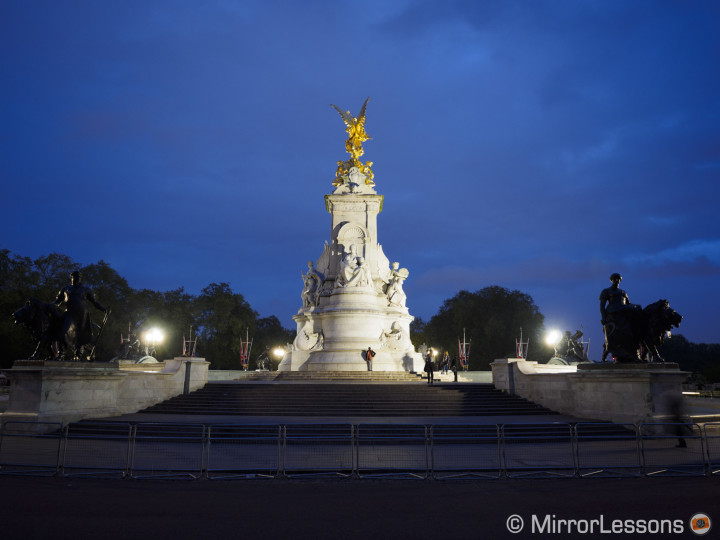
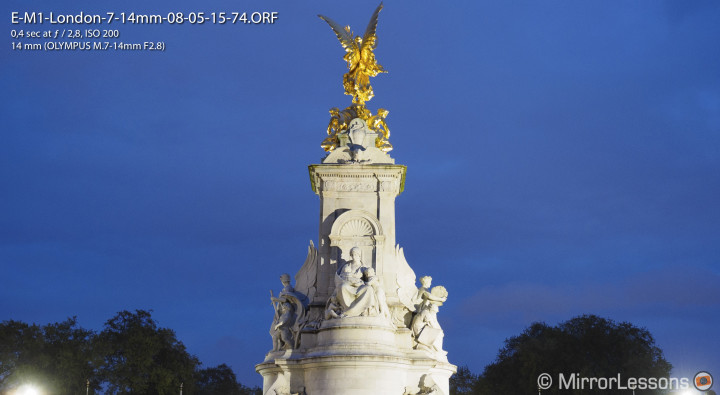
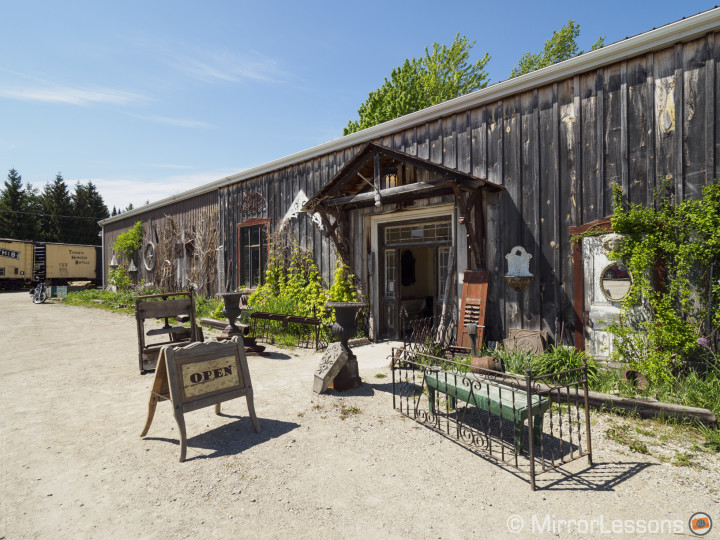
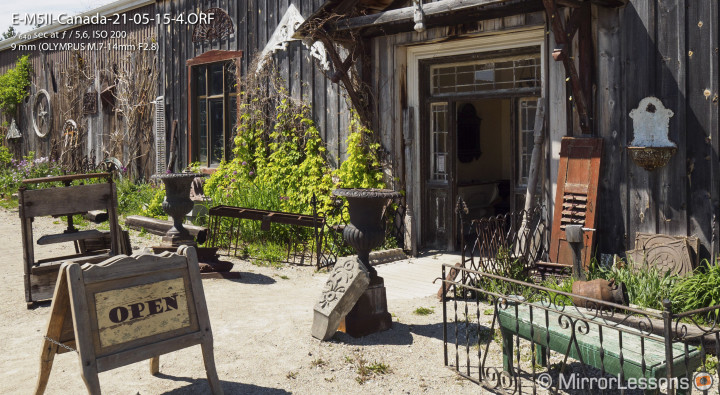
At the edges, the performance remains excellent – you really need to analyse the extreme edges and corners to find something worth mentioning. There is a lack of sharpness at f/2.8 that is almost entirely corrected from f/4. It is more present at 7mm while it is partially reduced at the longer focal lengths.
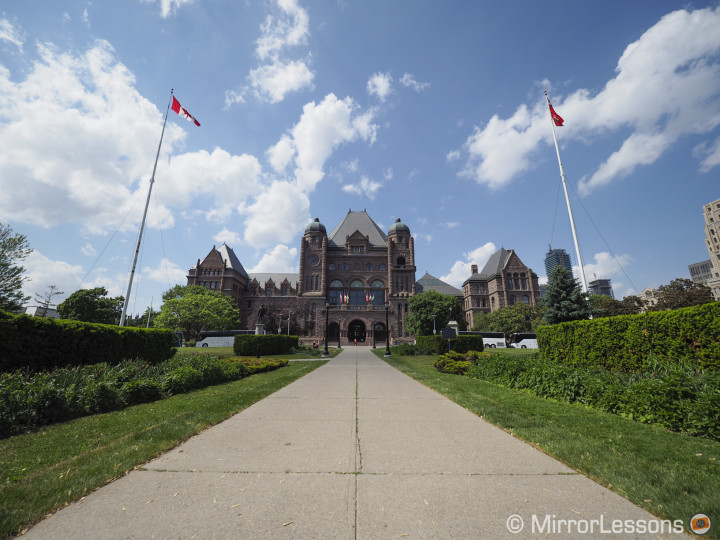
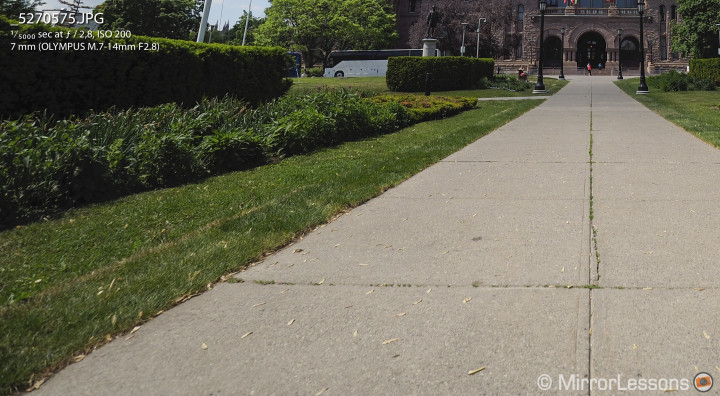
The lens is also capable of delivering excellent results with the 40/64mp High Res Shot function found on the OM-D E-M5 mark II. You can see an example below.
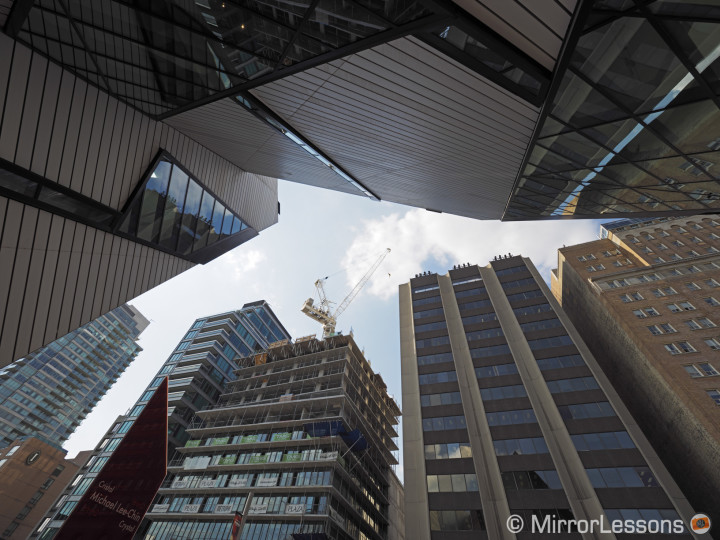
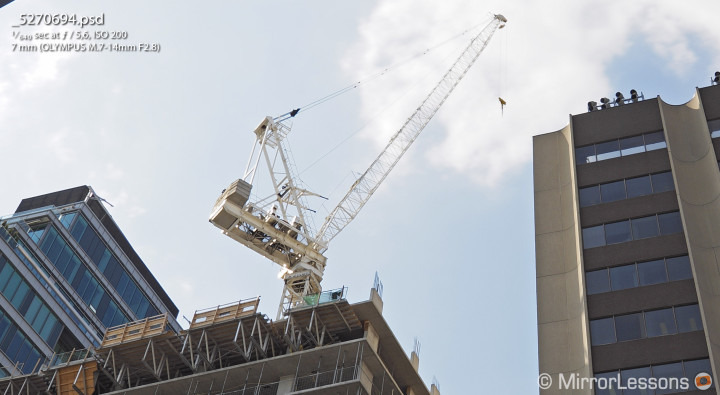
I haven’t noticed any relevant barrel distortion. The only distortion worth talking about is of course perspective distortion, which is the main characteristic of this type of lens. It can be of great use for architectural shots depending on how well the perspective distortion is contained. Some of it is tolerable but if distortion becomes too invasive, it can also be unpleasant.
It was by taking architectural shots that I could really evaluate the performance of the M.Zuiko 7-14mm.
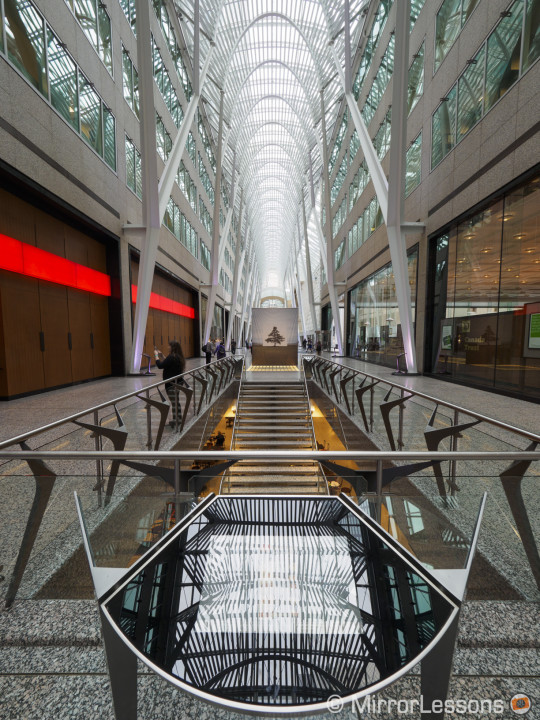
When using the shortest focal lengths like 7mm and 8mm, the amount of perspective distortion will of course be more pronounced depending on the composition and your distance from the geometrical lines. For example if you keep the sensor and the lens as parallel as possible to the vertical and horizontal lines in the scene you are are photographing, distortion is almost absent even in the case of vertical lines that are on the left or right edges of the frame.
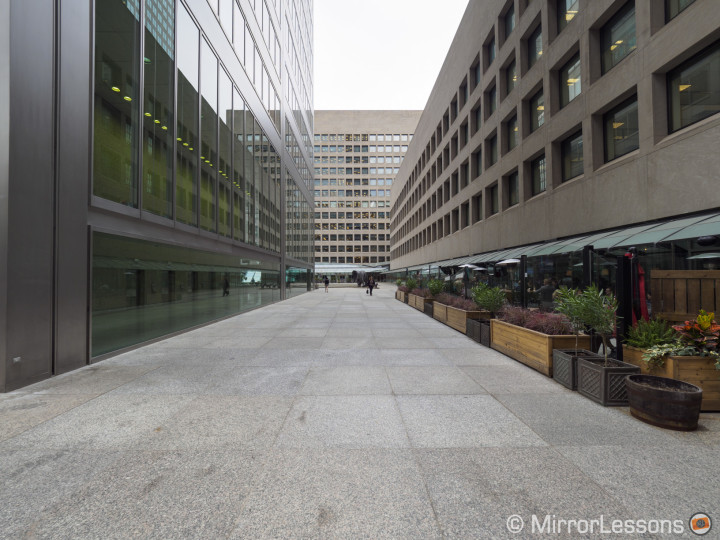
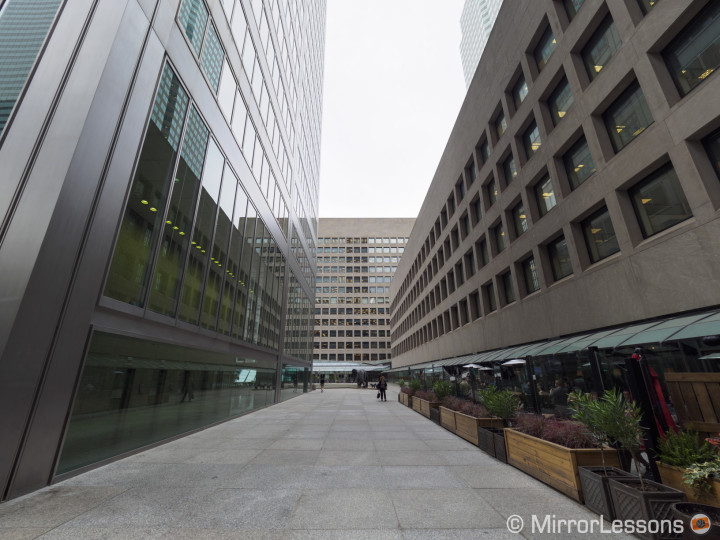
When vertical and horizontal lines aren’t parallel to the sensor the distortion will be more pronounced. Of course in some situations you can’t be at the right distance or height to take the photograph. A classic example is when you photograph a building from the street and have to tilt up in order to include the entire building in the frame. Of course the more you zoom in or use longer focal lengths, the more the perspective distortion will be reduced.
Overall I found the 7-14mm f/2.8 excellent even when photographing in tight spaces and indoor locations where the lack of space can accentuate distortion. It is definitely a valid lens to consider for architectural photography.
The lens is of course a great option for landscapes. It has a natural colour rendition and excellent micro contrast. You get the same type of rendition as the other Pro lenses: good sharpness, good contrast and vibrant colours.
When photographing people, you can get lots of distortion at 7mm especially if your subjects are not in the centre and are close to the lens. But at the right distance and with the right focal length, it can work well for group shots too.

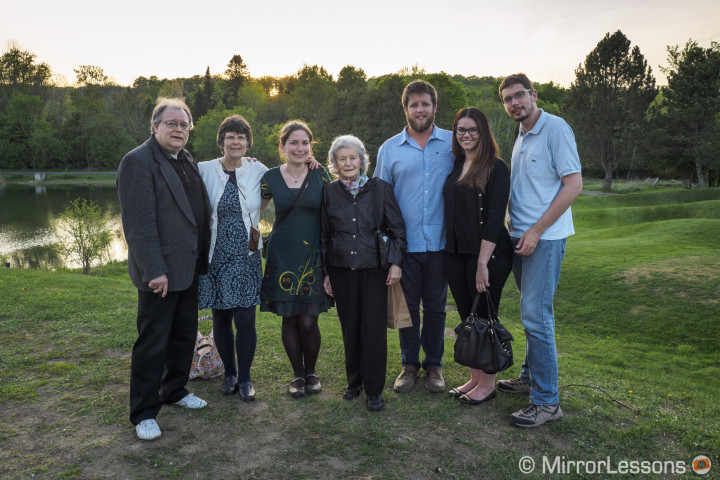
Through the lens: close focusing and flare
Another interesting characteristic of this lens is the minimum focus distance of 7.5cm (measured from the sensor) that remains constant throughout the entire zoom range and gives you excellent macro capabilities. Of course we aren’t anywhere near a 1:1 ratio but the lens can focus close enough to capture interesting details or to create original compositions. The sharpness remains fine at close distances even at f/2.8.
The bokeh is very pleasant which is is quite surprising considering that this is a wide-angle lens.
Even at 7mm the results are quite stunning like in the example below.
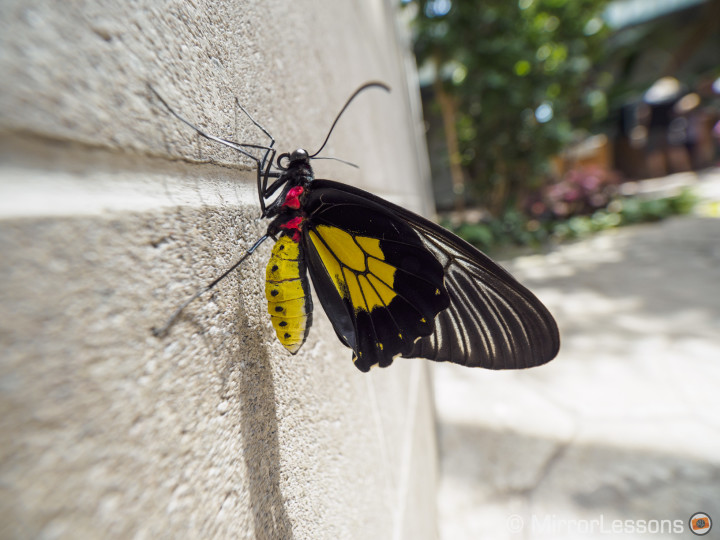
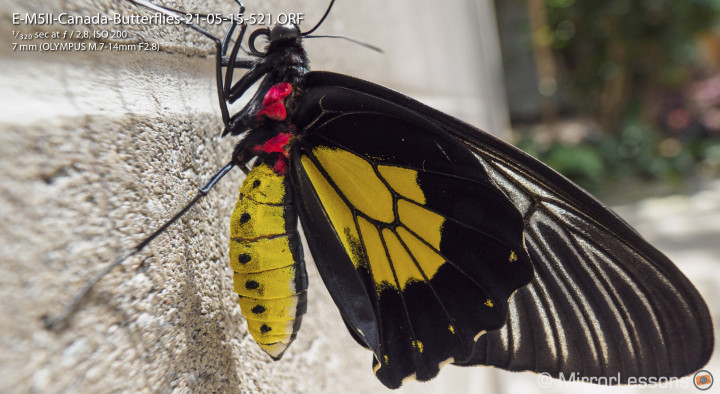
When zoomed in at 14mm, it becomes even better and you can really see how versatile this lens is. It is a characteristic that Olympus has implemented on all its Pro lenses. They all have very close focusing capabilities that remain constant throughout the entire zoom range. It is one of my favourite characteristics for sure.
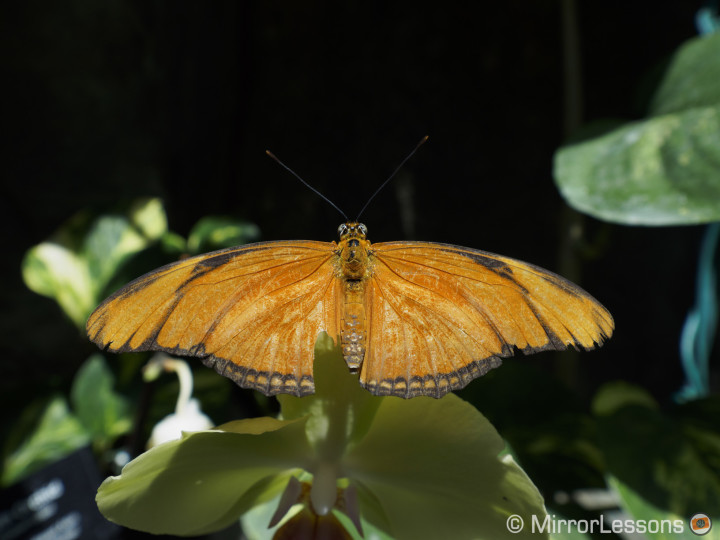
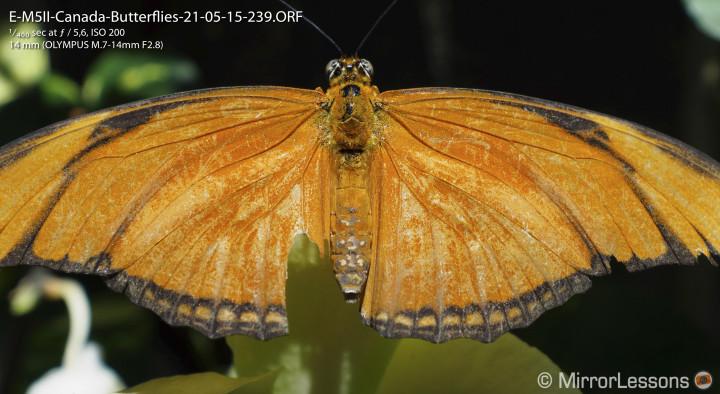
I didn’t find any relevant traces of chromatic aberration, apart from at the shortest focusing distances when using the fastest aperture. Vignetting is almost completely absent. The only real limit to be aware of is flare. Most of the time they are small but very much present when using the lens at 7mm. The reason is that at this focal length, the front element is very much exposed and the hood doesn’t protect it that much. Even when the sun or other strong sources of lights aren’t in the frame, you can end up with flares quite easily even when the light is coming from the left or the right like in the example below. I was concentrating on the bridge in my composition and the sun was on the left. I didn’t notice the flares in the middle until I saw the image on the computer.
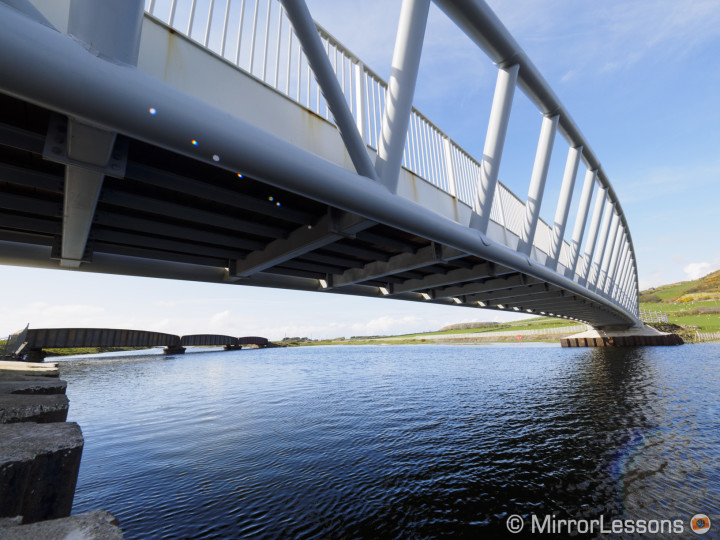
The easiest thing to do is always check for flares using the electronic viewfinder if your M4/3 cameras has one or to play back your picture and zoom in on your LCD screen after taking the shot. To get rid of these flares, I often used my left hand by positioning it above or to the side of the lens until I saw that the flare had gone. It is a very rudimental solution but works most of the time. You have to pay attention of course that your hand doesn’t enter the composition!
Below you can see more examples with flares. Most of the time, flares disappear at around 11mm because the lens is more protected by the hood. The second picture below shows the worst flare I got with this lens but it happened only once and the sun was clearly in my frame.
Autofocus
I used the lens mainly on the E-M5 mark II and occasionally on the OM-D E-M1. The autofocus was really fast on both cameras. I didn’t come across any problems except for when I reached the limit of the minimum focus distance. The autofocus is as quick and as accurate as with the 12-40mm. I almost never needed to switch to manual focus. This makes this lens excellent for many applications including weddings and events where such a wide angle and fast aperture can be of great use.

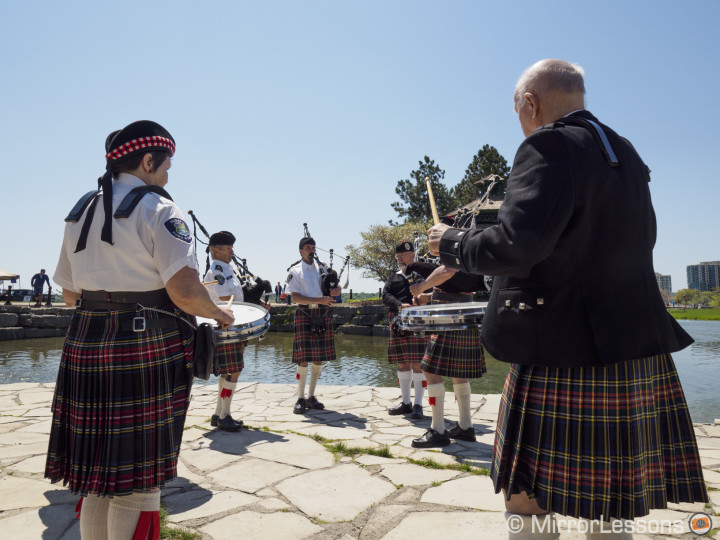
The autofocus is fast and silent when shooting video as far as the lens is concern. However in AF-C, the E-M5 mark II may hesitate a little more, just as it does with the 12-40mm.
Talking about video, the lens can also be an interesting option for filmmakers who use Black Magic Cinema cameras. Often these products have a Micro Four Thirds mount but a smaller sensor that gives approximately a x3 crop factor. So it is difficult to find a good wide-angle lens to use on the Cinema or Pocket Camera. The M.Zuiko 7-14mm would become approximately a 21-36mm, which could be an excellent solution also because of the f/2.8 aperture and close focusing distance.
Below you watch a few video shots taken with the E-M5 mark II starting at 4.45 min.
Conclusion
I really like super wide-angle lenses. You can play a lot with perspective and geometry to create an interesting composition. They are the perfect companion for landscapes, architecture and astrophotography when you have a fast aperture like this Olympus lens. I admit that most of the time I was more inspired to shoot at 7mm more than any other focal length and I think this very wide value is one of the main reasons to consider it.
Olympus is building a nice series of professional lenses and the M.Zuiko 7-14mm f/2.8 is proof once again of their top optical quality. You get excellent sharpness, very well controlled distortion and some close focusing capabilities that make it a surprisingly good lens for close-ups and details. I don’t think we can really ask for more than that.
Of course not everything is perfect. Lens flares are small but very much present at the shortest focal lengths. There is a lack of sharpness at the corners at 2.8 which isn’t surprising concerning the nature of the lens but it is worth mentioning. Also, it is on the heavy side for a Micro Four Thirds lens.
 What I like about the Olympus 7-14mm f/2.8 Pro:
What I like about the Olympus 7-14mm f/2.8 Pro:
- Excellent build quality
- Excellent sharpness
- Distortion well contained
- Nice close focusing capabilities with pleasant bokeh
 What I don’t like about the Olympus 7-14mm f/2.8 Pro:
What I don’t like about the Olympus 7-14mm f/2.8 Pro:
- Flares are small but always present up to 10mm and can be a little bit annoying
- It is heavy and somewhat unbalanced on smaller cameras like the OM-D E-M5/E-M10 and Pen cameras
- The extreme corners are softer at 7mm and f/2.8 but that shouldn’t be a big concern or surprise
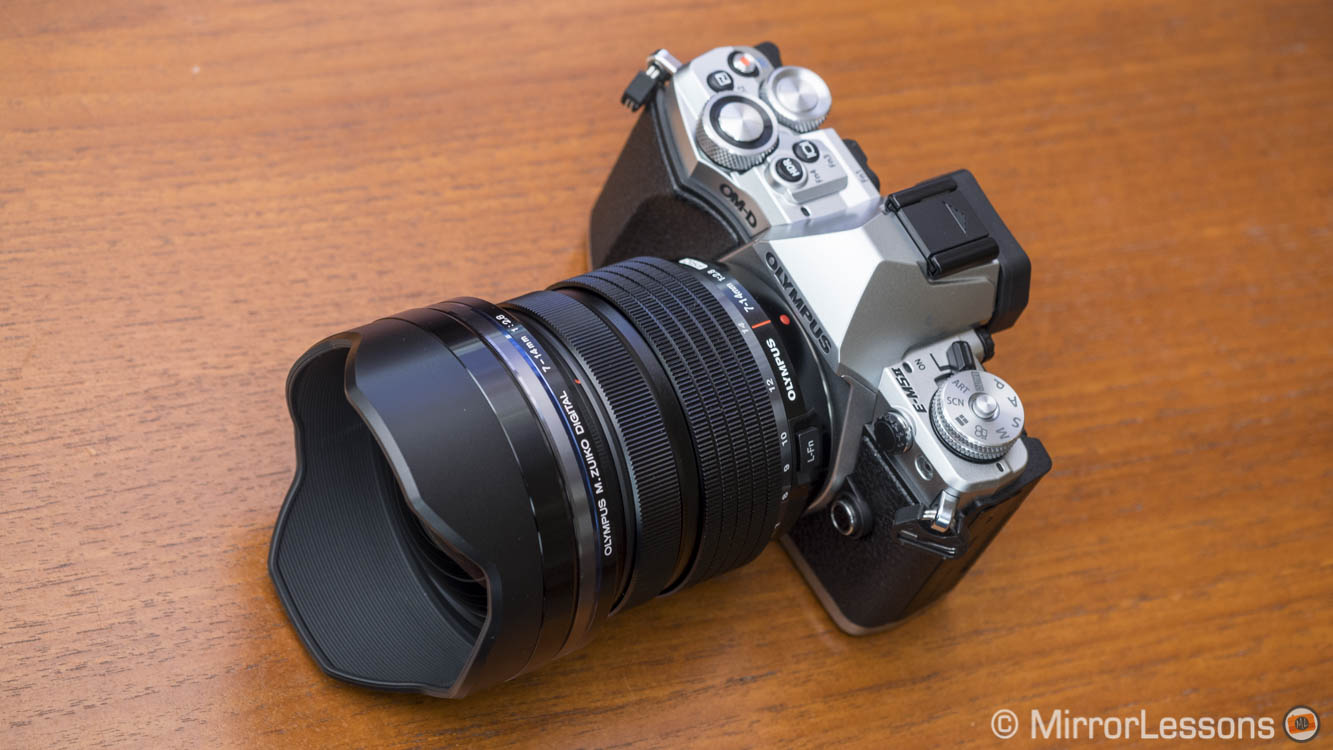
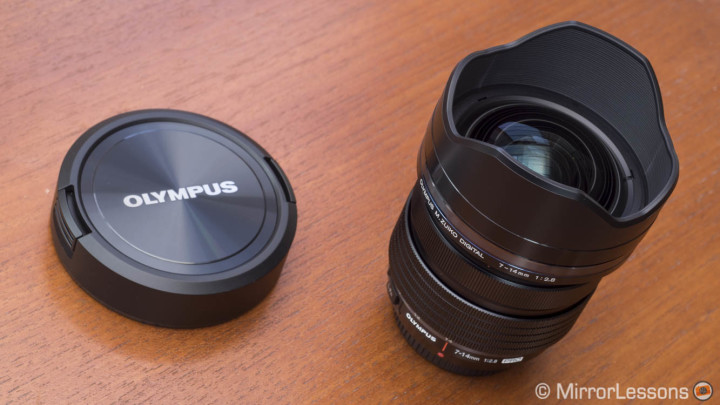
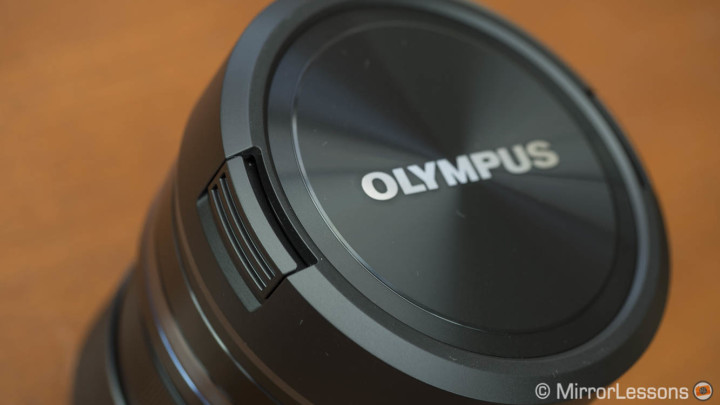
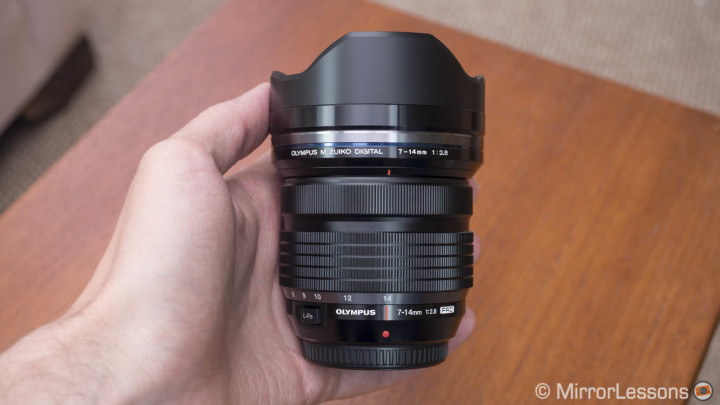
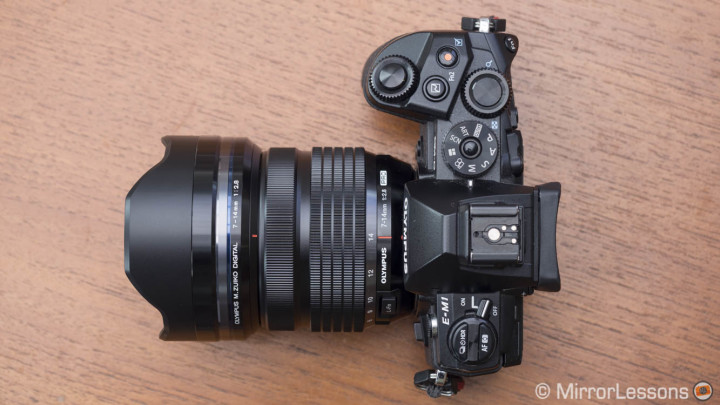
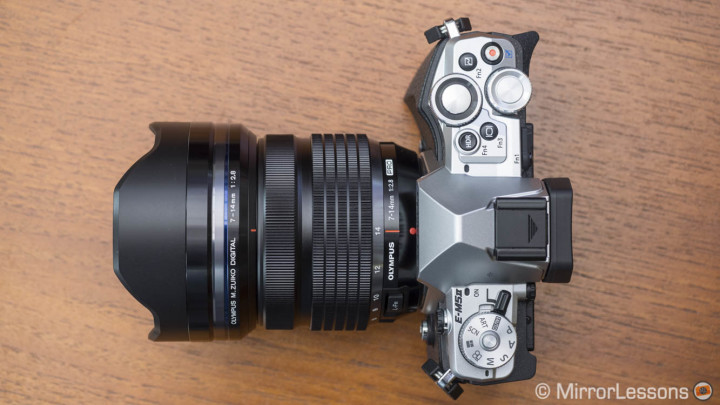
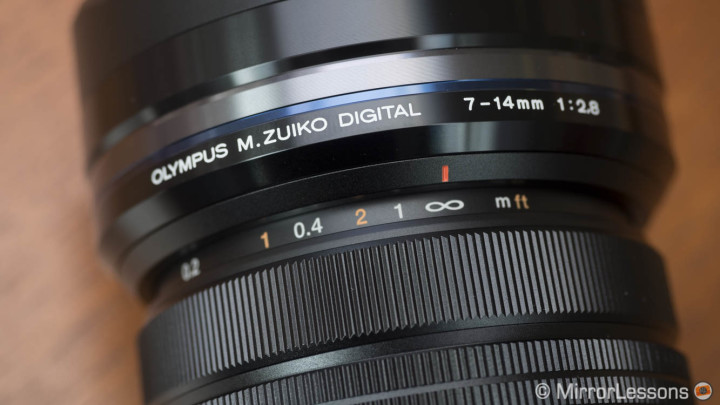
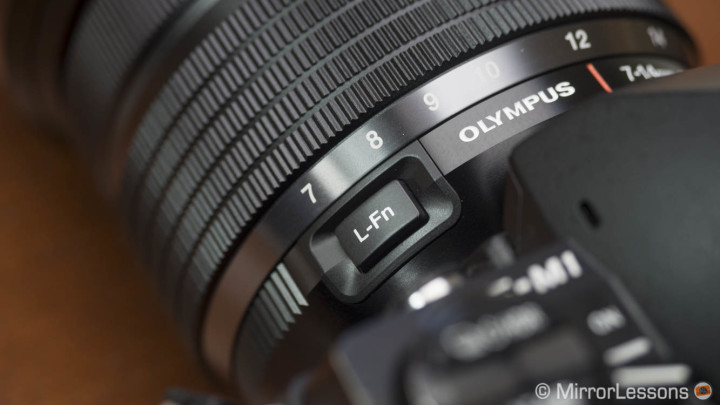
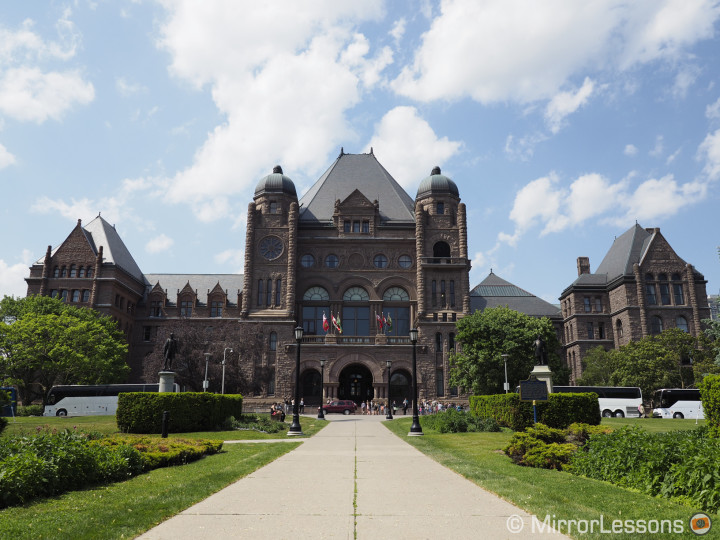

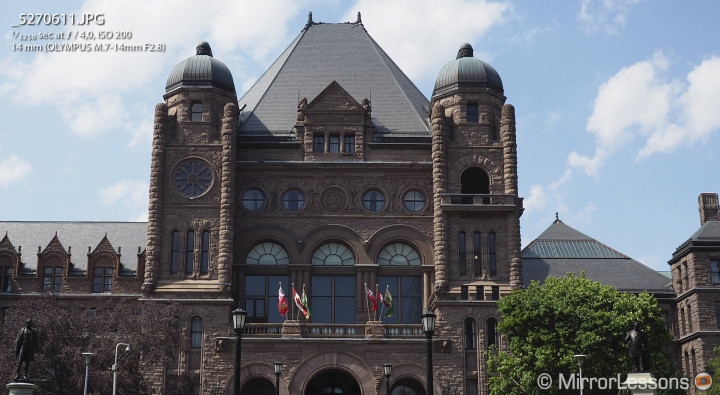
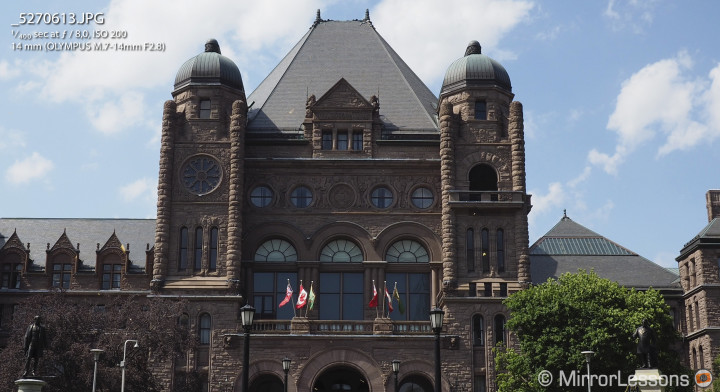
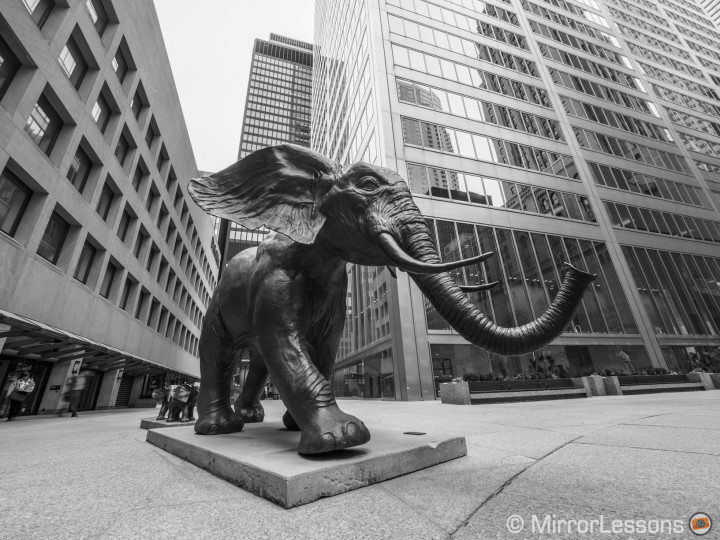
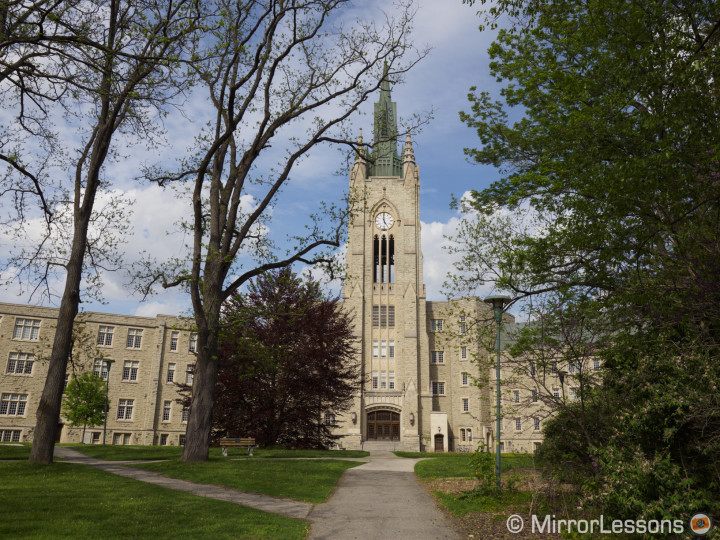
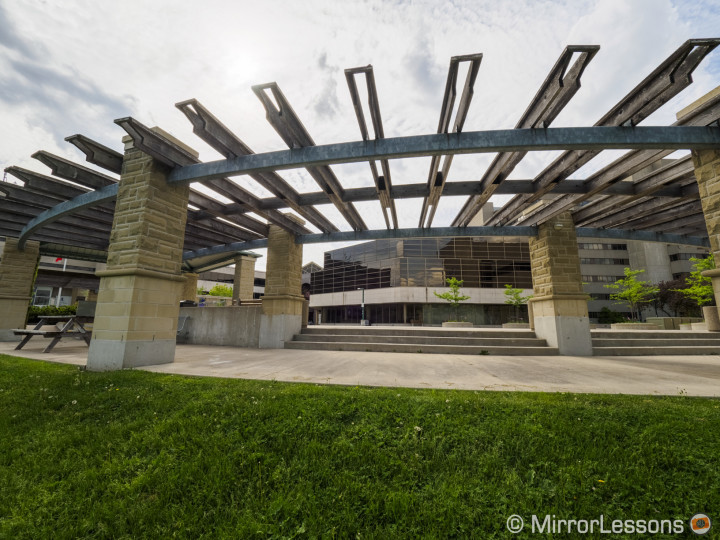
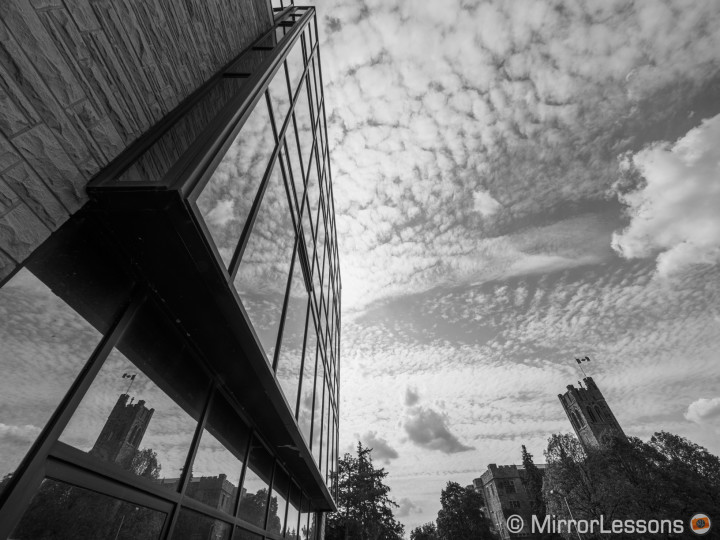
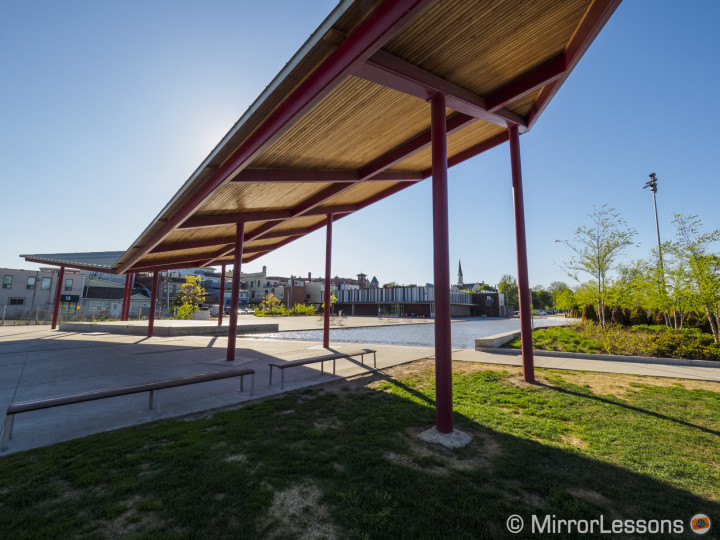
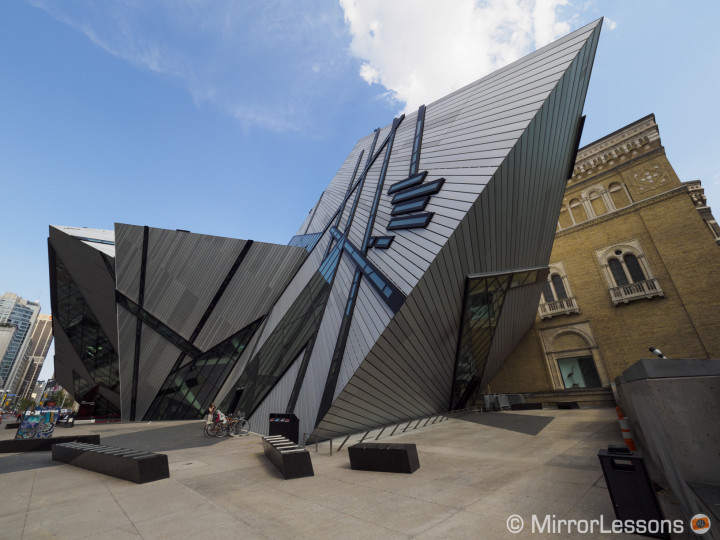
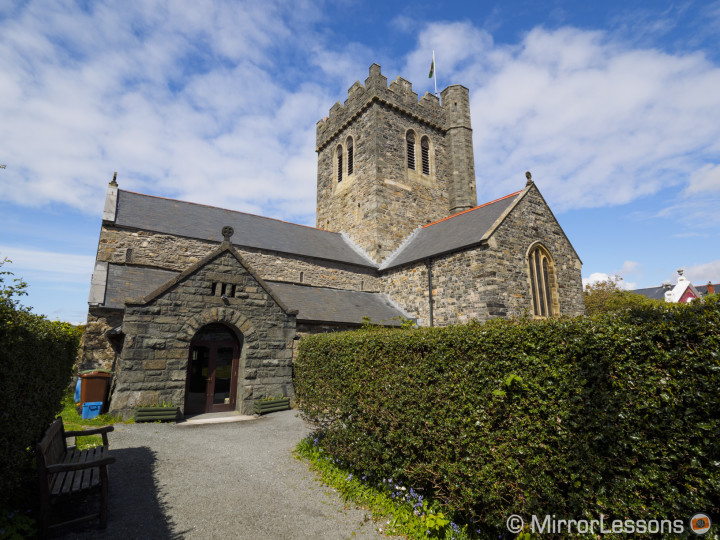
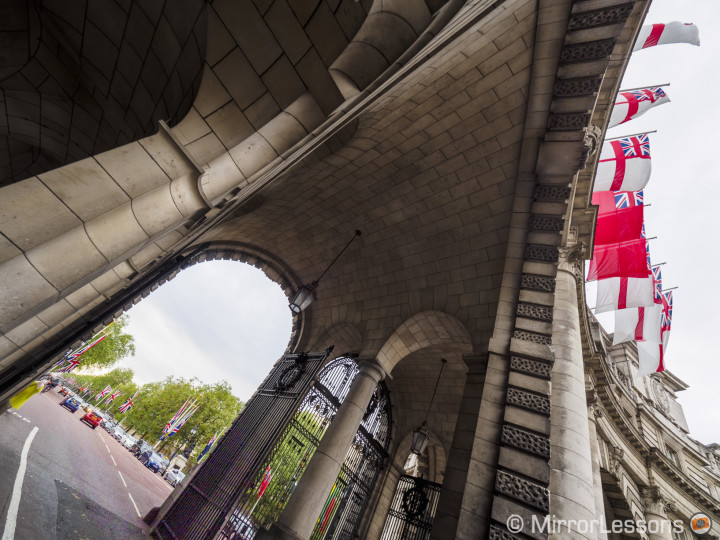
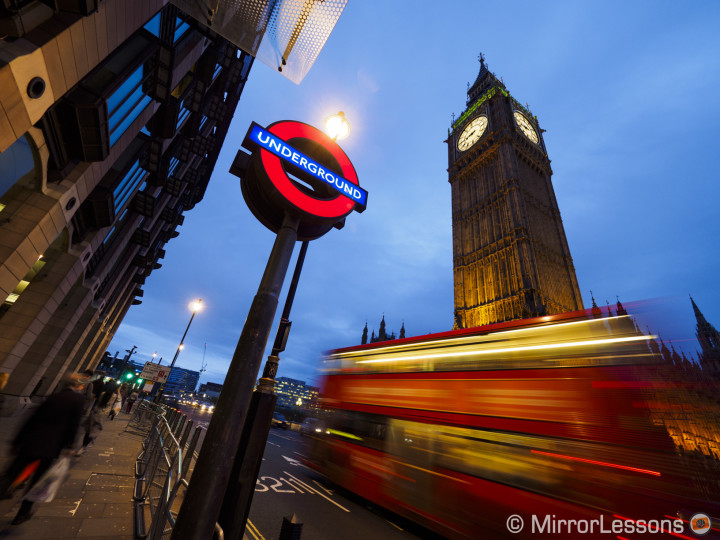
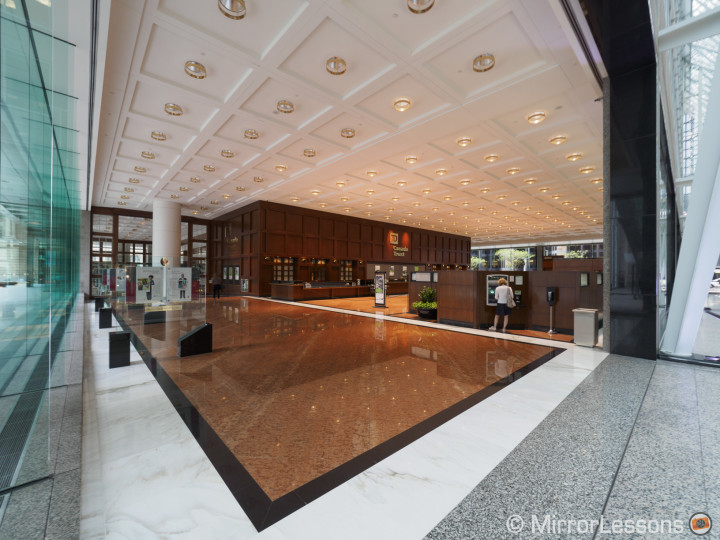

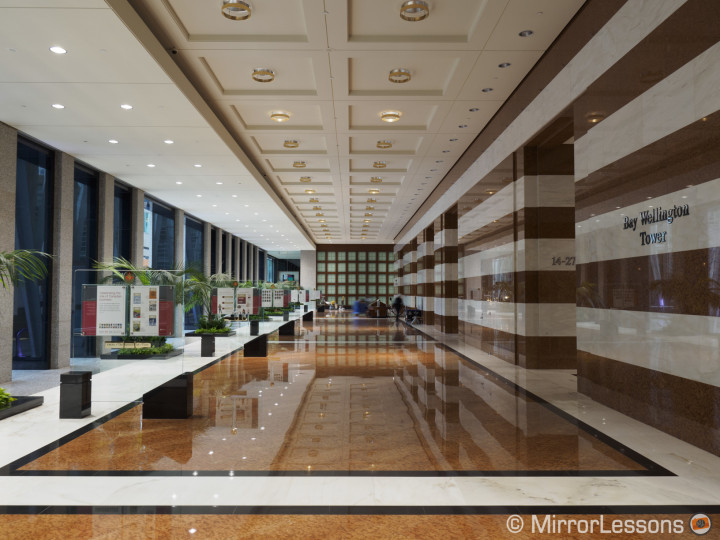
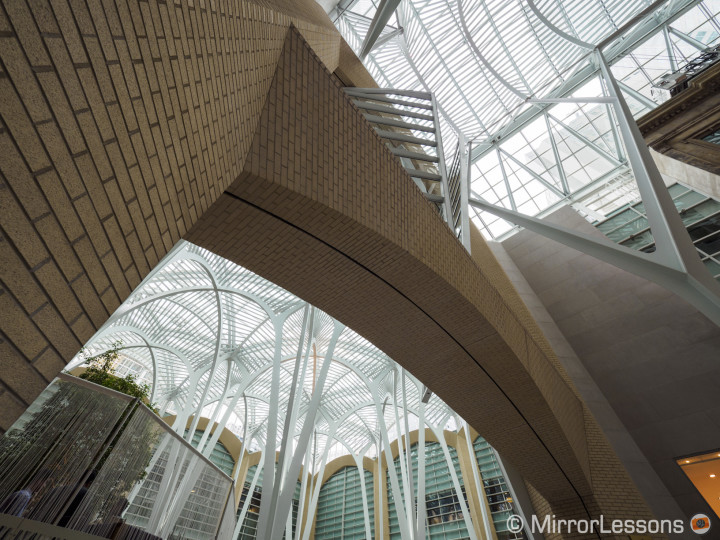
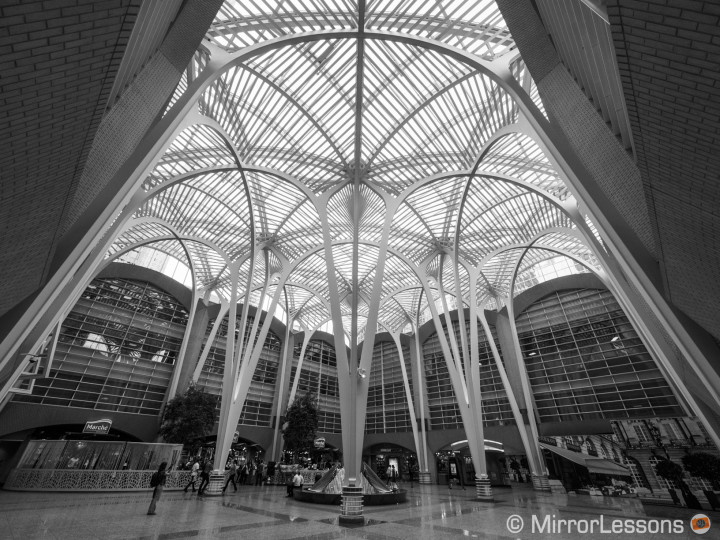
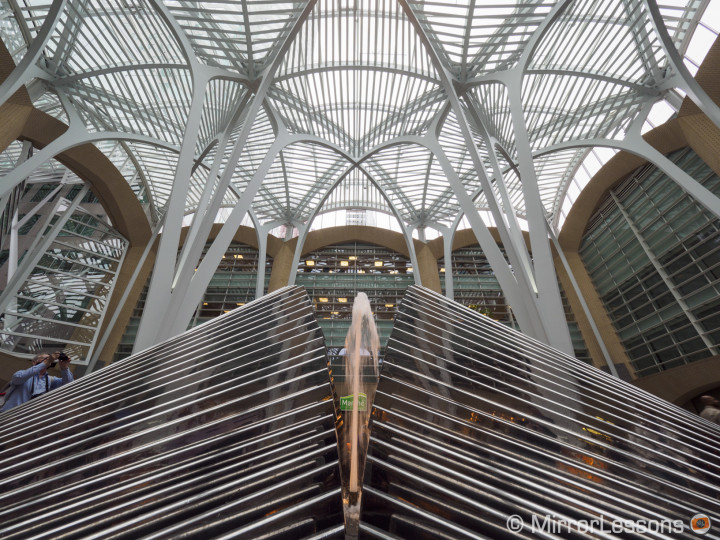
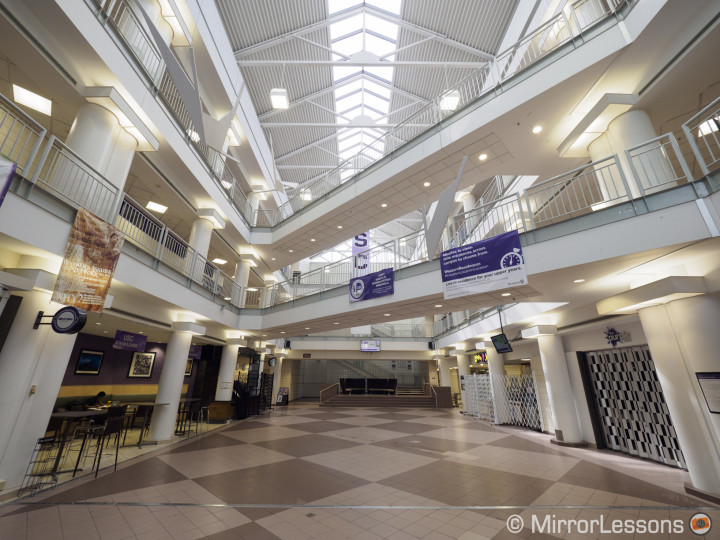
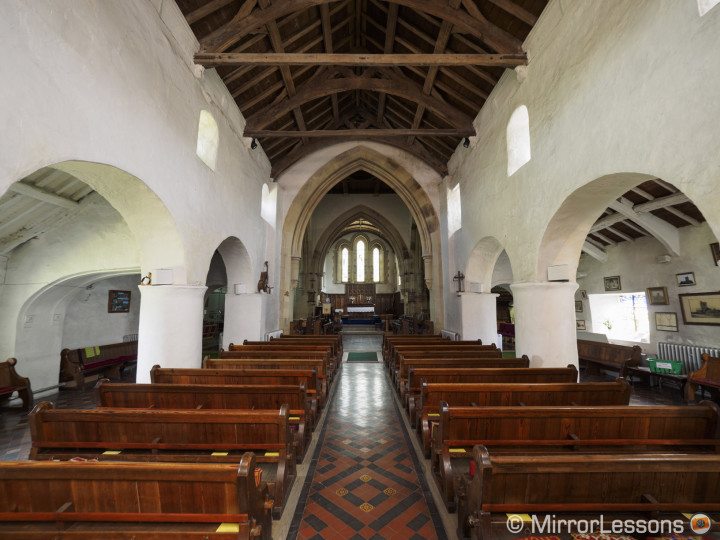
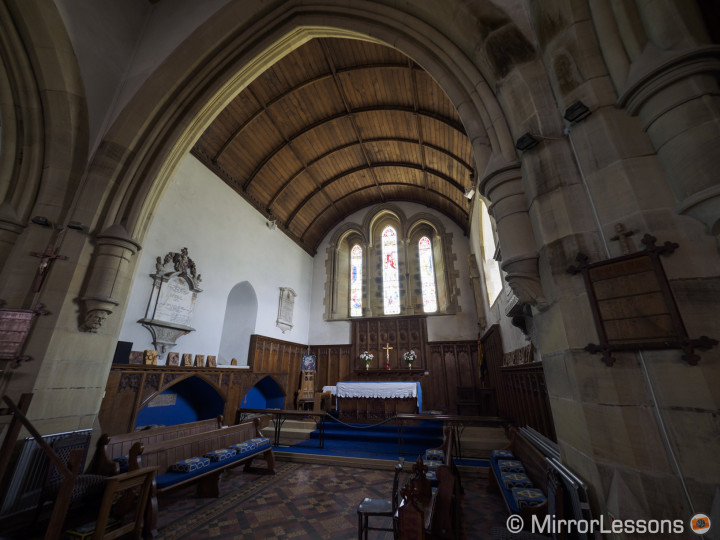
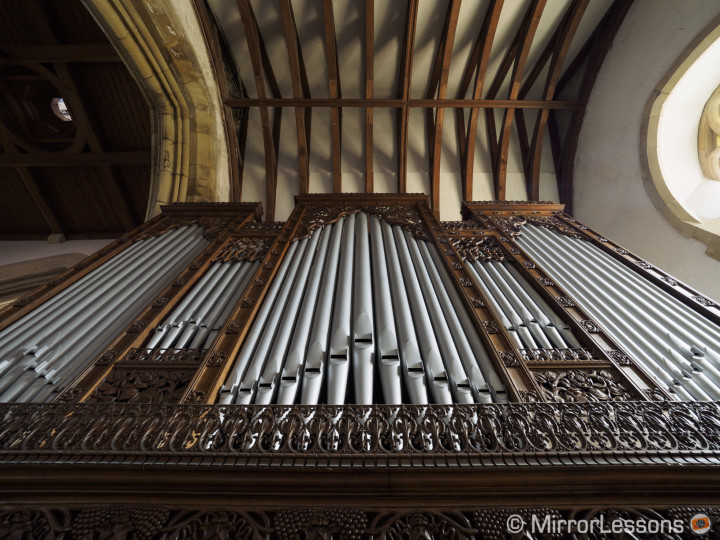

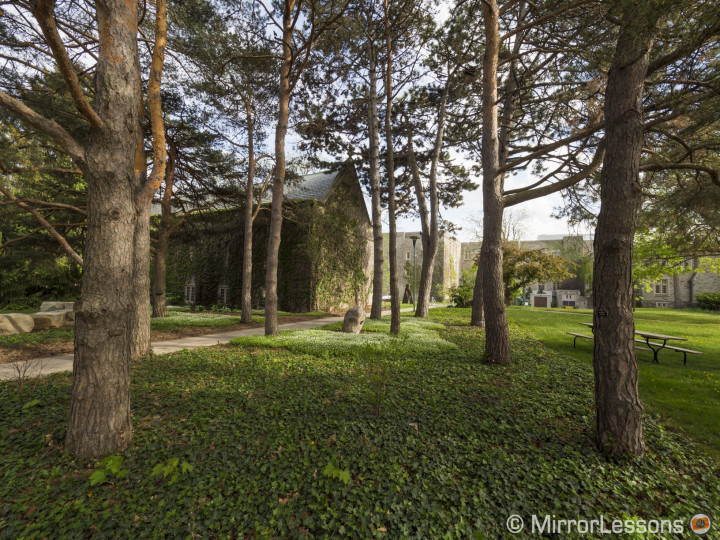
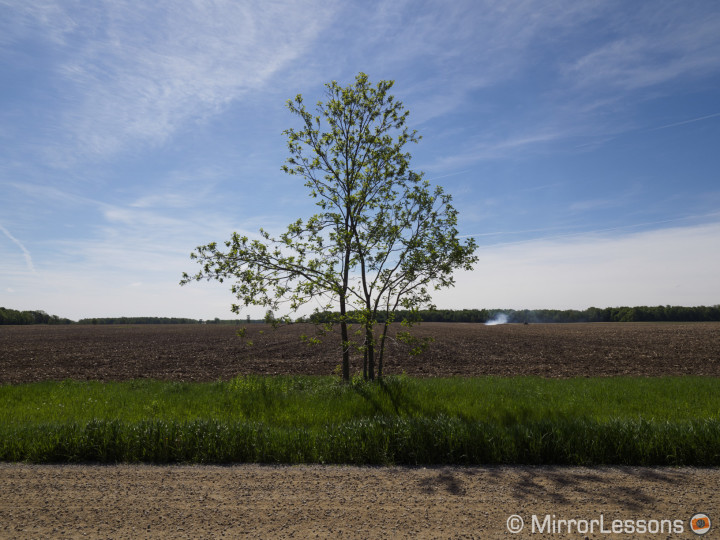

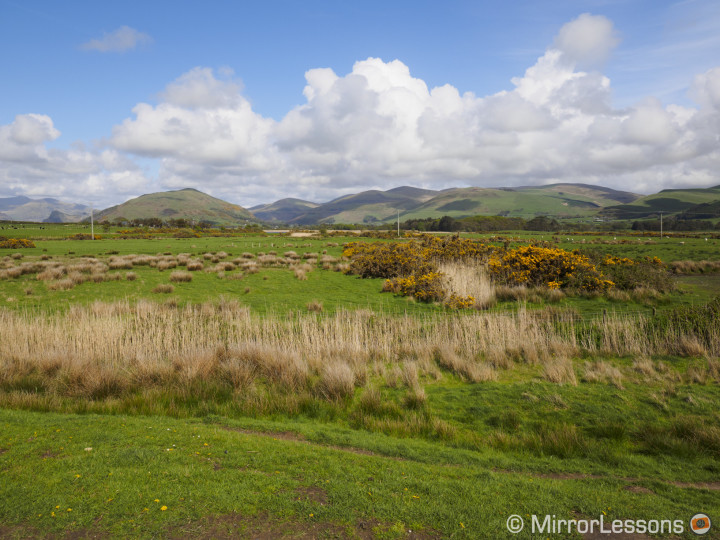
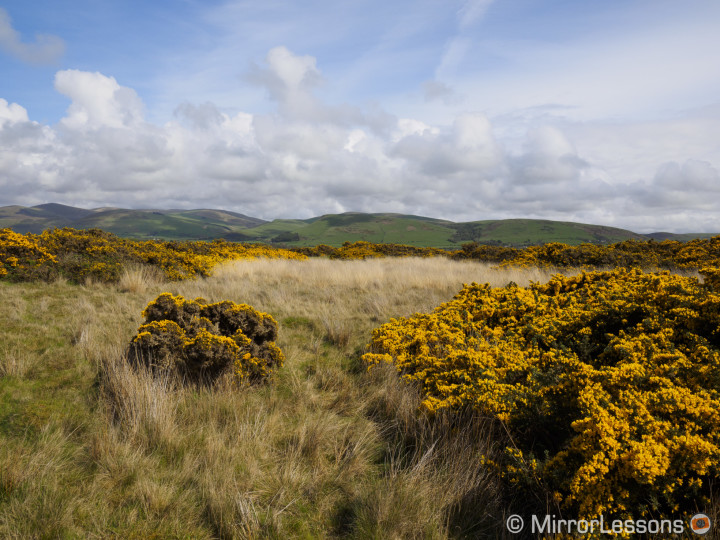
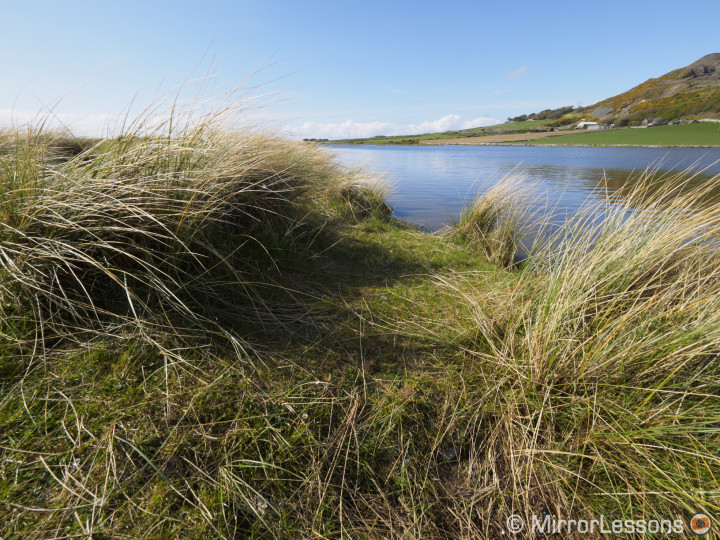
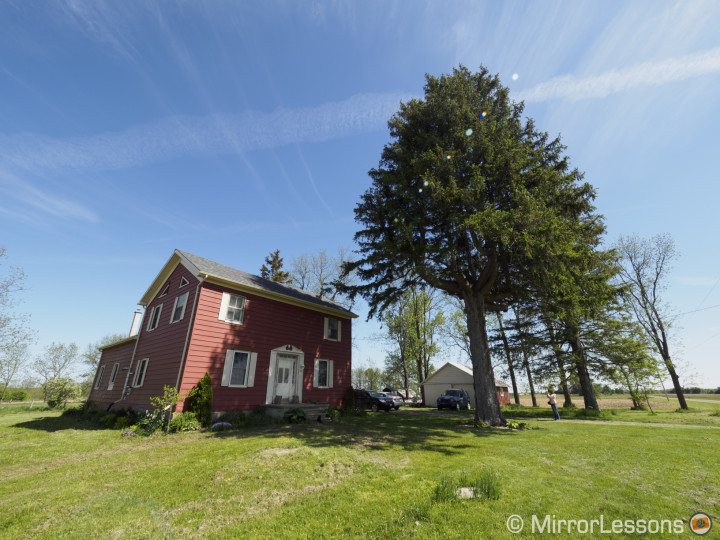
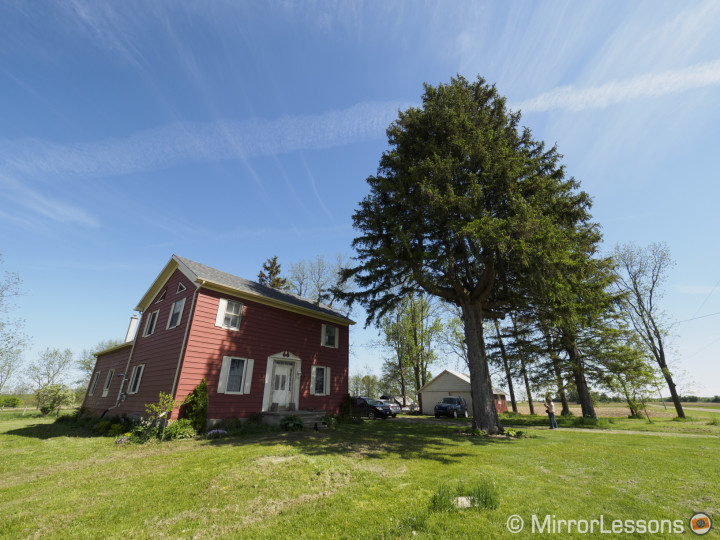

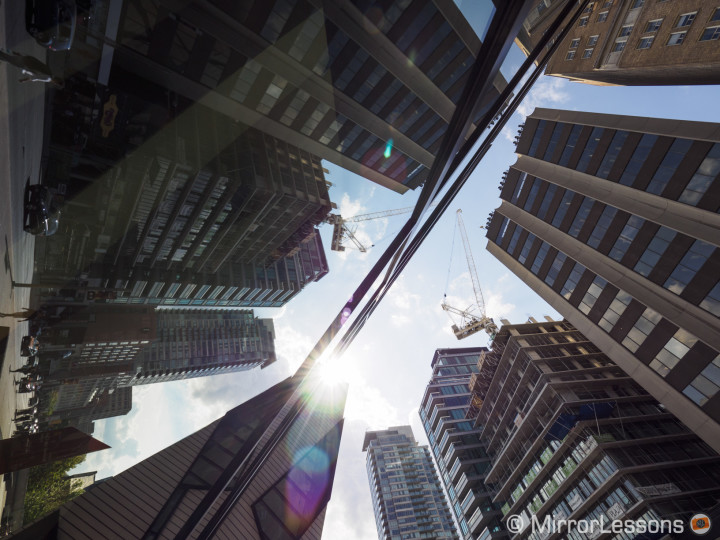
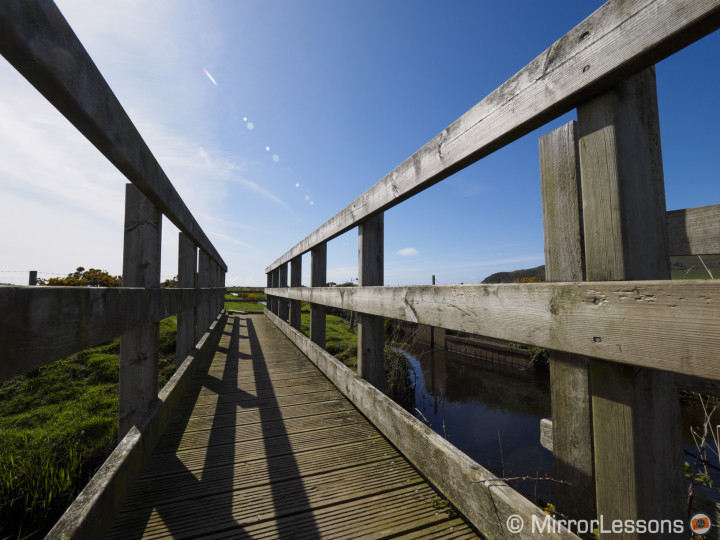
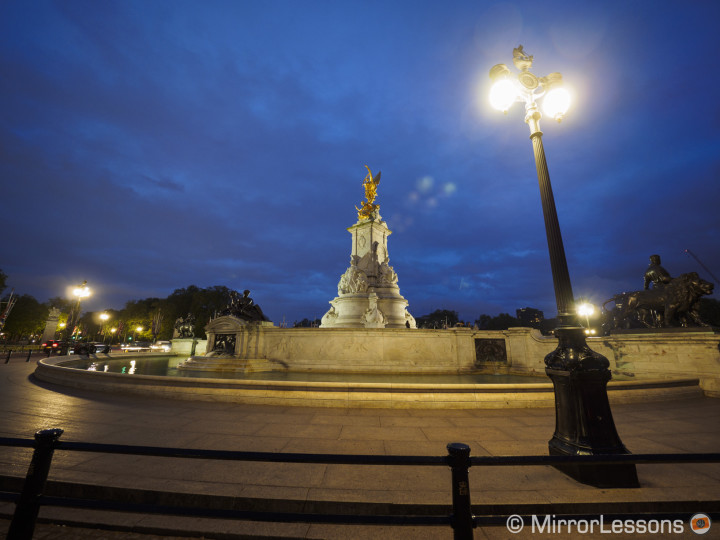
Thank you very much for the information. Now i’m quite clear.
The E-M1 has more noise with long exposures if you turn the noise reduction off. I know that astro-photographers prefer the E-M5 and E-M5 II so I guess the latter would be a better choice.
P.S.: the second link should be this one: http://www.philnortonphotography.co.uk/olympus-714-adapter.html
Hi Mathieu,
Thank you so much for taking time to address all my questions. (and for the links. The second link didn’t work)
I looked at Haida, But I think it’s bit too big. I have made my filter set with Formatt Hitech New Firecrest filters 67*85mm. They are quite good. So at the moment, I don’t want to change the filter set or buy new filters.
I think the the best point from the points your made is to (b) To wait till September what it will bring.
I definitely don’t want to buy the 12-40mm pro for landscape, city scape things. The 6mm that 9-18mm offers is quite important. In fact I want to have the 7-14mm pro lens for both of the reasons for it being fast and wider. Even though I don’t worry too much about the extra 4mm it gives. I’m ok with the 9mm end of the 9-18mm lens.
I have one last question: what is your opinion on OMD EM1 performance on long exposures, I have never owned one. Do you think it’s better to upgrade to OMD EM5 Mark II, than to EM1, if i wanted to upgrade for long exposure work?
Thank you very much again.
I am not sure about the 7-14mm 2.8 filter size as there isn’t a lot of options available right now (at least from the big filter companies). You need an adapter to put over the lens to attach filters like for example this one by Haida: http://www.haidaphoto.com/en/newsd.php?nid=76. However you have to make sure that your filters will be compatible and with the Haida example, it seems that the adapter takes larger filters than yours (150*150mm or 150*170mm). So the quest can be a little bit tricky. There are other products if you search on google however half of them seem produced independently so I am not sure how the build quality is. This one (http://www.philnortonphotography.co.uk/olympus-714-adapter.html) seems interesting but again the filter size is larger than yours.
If you really like your 25mm 0.95, you should keep it. As for the wide angle zoom lens, I guess it really depends on the following options:
a) buy new filters that fit a compatible adapter for the 7-14mm 2.8
b) wait to see if new filter adapters come out in the next months (maybe September with Photokina) and save more money in the meantime
c) buy the 12-40mm Pro instead. You sacrifice the extreme wide angle option but it is still a 2.8 lens and easier to mount filters on it.
I guess it really comes down to this: do you really want the 7-14mm because it’s a 2.8 lens or because you want to shoot at 7-10mm mainly?
As always, a balanced review. I always loved your reviews for that reason and always read several times buying my lenses. Now i have a problem, which i’d like to have your opinion.
First of all, I’m a hobby photographer(and student). I’m mostly doing long exposures, Landscapes, some architecture, and candid street like photos. I’m thinking of this lens, because it has the f/2.8 for night/ dusk dawn photography and to get the star busrt effect. I often likes shooting in Paris at dusk and dawn. Something which worries me is it doesn’t have filter thread. I already have 67*85mm with 52mm filter rings. I’d like to know what would likely to be 7-14mm, filter size?
Currently, I’m using 9-18mm lens with my omd em5. And I have 25mm f/0.95 Nokton for candid shots to get the moody look (I really love it and manual focus).
Now I have been thinking of few upgrading, But i’m not sure which is the best, May be you can help me with some points? (I was thinking if I really do need 12-40mm for it’s optical quality)
1) Save up little more and sell the 9-18mm and get the 7-14mm.
2) I have some troubles with OMD EM5 buttons at back(specially at early mornings it’s difficult with cold), instead of a lens, get OMD EM5 Mark II. (I heard that OMD EM1 is not so good compared EM5 Mark I for long exposures, it has more hot pixels)
3) Stick with OMD EM5, sell both 9-18mm, and Nokton 25mm (But it seems to me quite hard at the moment, i love it’s moody character, colour rendering, great manual focusing), and get optically superior 12-40mm
I’m not a professional, but i’m deeply into it. But makes me go after 7-14mm is it’s extra wideness, and it’s better optics. But in the other hand, i’m taking most of my night shots on a tripod. The 9-18mm doesn’t quite make that appealing sharp look to night images.
I’m so sorry for the long and tiresome post. But i really would like to have your opinion on this. OR if you have any other suggestions please feel to free to give me.
Yes it is a heavy lens but the optical quality is worth it. As for the flares, you will learn to avoid them with more experience and they are much less invasive in comparison to the Lumix 7-14mm 🙂
I came back to this review again as I started to think about the flares and the possibilities to avoid them. Thanks for that “use your left hand” tip 🙂 I will definitely try. I like this lens very much but I am still learning how to use it to do not get the perspective distortion that would be very unpleasant – its not so easy 🙂 And comparing to the small and lightweight 9-18mm .. ehh, its heavy.
how is this not a thing?
The 9-18mm is not a bad lens at all and is certainly the smallest and lightest. If you don’t need the constant aperture, it is a good and less expensive choice.
Nice review…would have been fun to throw in the Oly 9-18 for size comparison. Though it’s not in the same league, it is a favourite of mine because of size and the 18mm for all around use.
Well the Foveon sensor is something else. The details you can get with those Sigma cameras are stunning.
Snowdonia is a great area, we will certainly go back there 😉
Well that’s good to hear. They just lack some bite for me… perhaps because I’m considering a DP0 Quattro so have been perusing Foveon images. Decisions decisions.
P.S, keep up the good work, it’s always fun seeing North Wales in your reviews; I spend most weekends in Snowdonia.
I only find a lack of sharpness at the corners and mostly at 2.8 really.
I used this lens mostly at 7mm so I would definitely consider a 7mm prime.
True. It also depends on the camera body you’re using. On the GX7 it would unbalance a little even if the GX7 grip is excellent.
Looking at the Oly vs Panny comparisons I don’t think that the Oly is worse at rendering grass, I think that it’s noticeably softer all over the frame! Either they haven’t hit their numbers or the lens is due a firmware update similar to the one pushed for the 12-60mm; that made a huge difference to that lens’ resolving power which originally suffered from a softness akin to the 7-14mm shown here.
Hopefully Oly can do something about it because fine detail in landscapes are going to resemble SOOC Fuji files.
What is apparent here is that there should be a 7 mm prime lens instead of these 7-14 zooms. I use M43 under water and hardly use the Panasonic lens in any other focal lenght than the 7 mm.
Looks very good indeed. Problem is the 534 vs 300 grams, though. I find lenses up to about 400g. or thereabouts will balance quite well on my GX7. It’s kinda like the Oly 40-150 vs the Lumix 35-100, the Oly pro-lenses are just a bit heavy for my taste..
I only try the Kowa lens at the UK photoshow two years ago. It left me with a positive impression concerning the lack of distortion.
Thanks for the review ! Did you tried the Kowa 8.5mm f2.8?
How is it compare to the Oly and Pana 7-14mm?
I guess you mean something like this: https://www.mirrorlessons.com/wp-content/uploads/2015/05/Olympus-7-14mm-2.8-image-samples-36-720×540.jpg
That was taken with the Oly 7-14mm 2.8 on the E-M1. It is the only time I had this with the Olympus lens but to be honest I’ve seen this kind of purple flare with lots of M4/3 lens/bodies. It seems to be a characteristic of the system.
The Oly 7-14 looks like a giant beside the Lumix. I remember the Lumix having brilliant color rendering, so I think the Oly does equally well. I’d prefer to go for a light lens like the Lumix, but there’s a caveat: I had ugly purple fringing in some high contrast images when using the Lumix 7-14 on Oly Body (E-PL5): https://www.flickr.com/photos/100003468@N05/14644178326/in/dateposted-public/
This was completely removed (in software processing I guess) in the raw files of Panasonic Bodies.
Not sure whether the Oly would produce some similar effects on a Panasonic body … as long as you’d have a Lumix Body, maybe you could check?